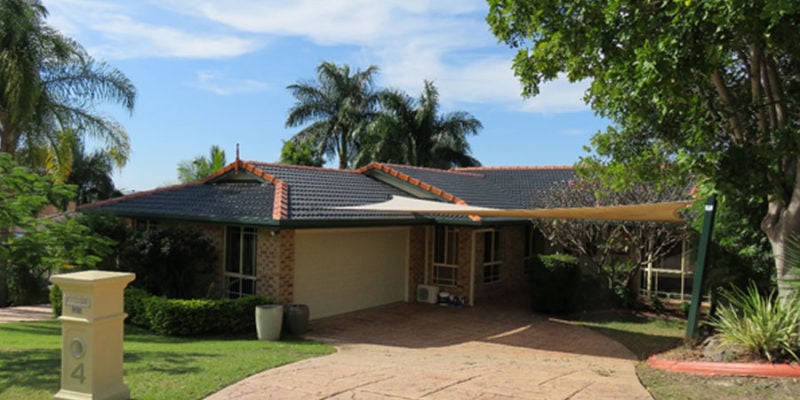Roofing in Los Angeles

The roof is far and away one of the most important parts of any home. It provides comfort and protection, plus, with the addition of solar panels, it can save you money. Naturally, such an important part of the home has many different styles and options from which to choose. Pacific Green Homes can help to narrow down the choices and help you to select the type of roof that is perfect for your home and that is within your budget.
Roofing Inspection
Annual inspections can help you to determine if you need a new roof. Examine it for shingles that are cracked, broken, curled, or missing. You should also look for rust spots on the weatherproofing, the growth of moss or lichen, and the discoloration or peeling of paint under the eaves.
You don’t have to get on the roof to inspect it, using a pair of binoculars from a distant enough vantage point is good enough. You should also check for dark spots on the ceiling and on the walls, these are signs that the roof has a leak. If the damage is major, then you might need a roof replacement, which is where Pacific Green Homes can help you.
Roofing Replacement
Damage is not the only reason for a roof replacement, it could also be part of a home renovation; whatever the case may be, here are some options that can help you make the right decision.
NB – A Class A fire rating is the best, with each subsequent letter being slightly worse. Square means 100 square feet.
Asphalt/Composition Shingles
This is the most common roofing type in America: it comprises a mesh fiberglass mat sandwiched between two layers of asphalt. The top layer is embedded with stone granules that provide color and reflect sunlight.
Pros of Asphalt Shingles
- They’re the most affordable roofing option.
- They offer good fire protection.
- They come in a wide variety of colors and styles.
- Repairs are easy and cost-effective.
Cons of Asphalt Shingles
- They need to be replaced more often than other roofing types, making them a more expensive long-term option.
- In shaded areas, mold or algae growth can be a problem unless they are treated with anti-algae agents.
- They need regular cleaning.
- Rapid, high temperature changes can cause them to crack.
Longevity
10 to 25 years
Eco-friendliness
They can technically be recycled into paving, but they tend to end up in landfills and produce a lot of waste because few recycling facilities accept them.
Installation Cost for an Average Home
$350 to $450 per square
Wood Shingles and Shakes
These are a very attractive option to any home, giving it a natural, rustic look. Wood shingles are machine cut, so they are thinner and have a more uniform look. Shakes are hand cut and are thicker, heavier, and more expensive than shingles.
Pros of Shingles and Shakes
- They perform well in drier climates.
- Some wood shingle/shake materials, like cedar and redwood, contain natural oils that are moisture and insect resistant.
- Wood has superior insulation to asphalt.
- Treated wood shingles have a class A fire rating.
Cons of Shingles and Shakes
- Non-treated wood has a Class C fire rating.
- Wood roofing is forbidden in areas regularly threatened by wildfires.
- Wood is tough and sturdy but repairs can be expensive.
- They need to be cleaned regularly to prevent moss or algae growth.
- Tannins released from the wood can cause it to stain.
Longevity
Shingles – 30 to 40 years
Shakes – 20 to 40 years
Eco-friendliness
Shakes and Shingles are manufactured using old growth and salvaged trees, plus old shingles and shakes can be recycled into mulch, compost, or wood chips.
Installation Cost for an Average Home
Shingles – $450 to $900
Shakes – $650 to $1100
Metal Roofs
Metal roofs have become more popular of late because of their durability. They are available in a wide array of styles, can be made from different metals like aluminum, copper, and zinc. They can also be installed very quickly.
Pros of Metal Roofs
- They are durable and long-lasting.
- They are very low maintenance.
- They reflect radiant heat and keep the home cool.
- Many metal roofs have a Class A fire rating.
- They are lightweight and impact-resistant.
- Many are strong enough to withstand heavy winds and hail.
- They can be installed over existing asphalt roofs.
Cons of Metal Roofs
- Installation costs are higher than asphalt and wood.
- They can be noisier than other roofing materials in the rain, requiring extra insulation.
- Replacing metal panels is more expensive than other materials.
Longevity
50 to 100 years
Eco-friendliness
Most of them are made from recycled materials and they can be recycled at the end of their lifespan. Reflective coated metal roofs can reduce cooling costs by 10% to 15% and can qualify for a federal energy efficiency tax credit of up to $500.
Installation Cost for an Average Home
$700 to $1200 per square
Clay or Concrete Tiles
This is a popular roofing option in the Southwest because of its attractiveness and durability, but it is a good choice in any part of the country for those same reasons. Concrete tiles use a lightweight blend that reduces the weight, but keeps the strength, of concrete.
Pros of Clay and Concrete Tiles
- They’re good for drier climates since they have a Class A fire rating.
- They will not rot and are resistant to bug and insect damage.
- They can resist extreme weather conditions.
- They come in a variety of styles and textures and look good on most homes.
- Tiles with lighter colors reflect sunlight, keeping the home cooler and saving energy.
Cons of Clay and Concrete Tiles
- They cost more than asphalt, metal, and wood tiles.
- They can be heavy, so the roof might need extra support.
- They can crack if they are trod upon carelessly.
Longevity
>100 years
Eco-friendliness
Clay and concrete tiles do not use any limited natural resources, plus clay can be recycled and used in new building materials.
Installation Cost for an Average Home
$1200 to $2500 per square
Slate Tiles
Slate tiles come in natural and synthetic varieties, both of which are good options. They are better suited for steeper roofs because of their ability to shed rain and snow. This is also why they are so popular in the Eastern parts of the country.
Pros of Slate Tiles
- Natural slate can last for a lifetime.
- Synthetic slate is light and strong.
- Slate has a Class A fire rating.
- Slate is a low maintenance material.
Cons of Slate Tiles
- Natural slate is the heaviest roofing material, so residences have to be evaluated to check if they can support the weight.
- If extra support is required to hold the weight, that could add to the installation cost.
- Slate can be fragile when walked upon if the person doing so is not very careful.
- Replacing broken tiles is difficult because it can be hard to find matching tiles.
Longevity of Slate Tiles
Natural slate – >100 years
Synthetic slate – 40 years to 60 years
Eco-friendliness
Manufacturing slate has a low environmental impact, and it can be reused and recycled. Synthetic slate can be made using recycled rubber or plastic, which can in turn be recycled. Slate made using virgin rubber or plastic can also be recycled.
Installation Cost of Slate Tiles
Natural Slate – $1000 to $2000 per square foot
Synthetic Slate – $500 per square foot
Roofing Los Angeles: Know Your Choices
These are your options when selecting a material for your roof, each has its advantages and disadvantages so choose wisely. If you need help making a choice, we can help you perform a cost-benefit analysis so that you make a smart, informed decision.






